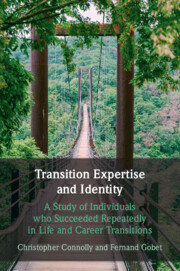 Transition Expertise and Identity
Transition Expertise and Identity Mental Adaptation and Evolution
from Part II - Transition Expertise
Published online by Cambridge University Press: 30 May 2024
This chapter addresses how cognitive flexibility enables an individual to respond adaptively to new situations and respond appropriately to any situation. Interrupting automaticity avoids being trapped in mindsets that foreclose generating new options; avoiding reductive bias reduces the tendency to oversimplify and turn dynamic processes into fixed objects and make complex interactions linear; avoiding functional fixedness reduces the tendency to apply the same solution to different situations; and cognitive connectivity opens up to new approaches in which mental models can be transformed, schemata reorganized, and cognitive bridges built between previous expertise and new situations. This kind of cognitive flexibility enables individuals to respond and adapt to the new situation into which they are moving. This is discussed in light of the retrospective interviews with twenty-four elite performers in three domains (business, sports, and music) who successfully and repeatedly transitioned to higher positions within their field.
To save this book to your Kindle, first ensure [email protected] is added to your Approved Personal Document E-mail List under your Personal Document Settings on the Manage Your Content and Devices page of your Amazon account. Then enter the ‘name’ part of your Kindle email address below. Find out more about saving to your Kindle.
Note you can select to save to either the @free.kindle.com or @kindle.com variations. ‘@free.kindle.com’ emails are free but can only be saved to your device when it is connected to wi-fi. ‘@kindle.com’ emails can be delivered even when you are not connected to wi-fi, but note that service fees apply.
Find out more about the Kindle Personal Document Service.
To save content items to your account, please confirm that you agree to abide by our usage policies. If this is the first time you use this feature, you will be asked to authorise Cambridge Core to connect with your account. Find out more about saving content to Dropbox.
To save content items to your account, please confirm that you agree to abide by our usage policies. If this is the first time you use this feature, you will be asked to authorise Cambridge Core to connect with your account. Find out more about saving content to Google Drive.